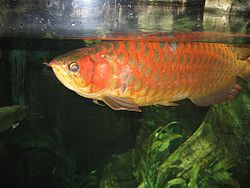Native to Southeast Asia, Asian arowanas inhabit blackwater rivers, slow-moving waters flowing through forested swamps and wetlands. Adults feed on other fish, while juveniles feed on insects.[4]
These popular aquarium fish have special cultural significance in areas influenced by Chinese culture. The name dragon fish stems from their resemblance to the Chinese dragon. This popularity has had both positive and negative effects on their status as endangered species.
History And Popularizations
Like all members of Osteoglossidae, Asian arowanas are highly adapted to fresh water and are incapable of surviving in the ocean. Therefore, their spread throughout the islands of southeast Asia suggests they diverged from other osteoglossids before the continental breakup was complete. Genetic studies have confirmed this hypothesis, showing that their ancestor of the Asian arowanas diverged from the ancestor of the Australian arowanas, S. jardinii and S. leichardti, about 140 million years ago, during the Early Cretaceous period. This divergence took place in the eastern margin of Gondwanaland, with the ancestors of Asian arowanas carried on the Indian subcontinent or smaller landmasses into Asia. The morphological similarity of all Scleropages species shows that little evolutionary change has taken place recently for these ancient fish.[5]
The first description of these species was published between 1839 and 1844 (1844 is the date commonly cited) by German naturalists Salomon Müller and Hermann Schlegel, under the name Osteoglossum formosum, although later this species was placed in Scleropages with the name S. formosus.[6]
Several distinct, naturally occurring colour varieties are recognised, each found in a specific geographic region. They include the following:
- The green is the most common variety, found in Indonesia (Kalimantan and Sumatra), Vietnam, Myanmar, Thailand, Cambodia, and Malaysia.
- The silver Asian (not to be confused with the silver arowana, Osteoglossum bicirrhosum) is considered part of the green variety by some. It has two subvarieties, the "grey tail silver" or "Pinoh arowana," and the "yellow tail silver," each found in a different part of the island of Borneo in Indonesia.
- The red-tailed golden is found in northern Sumatra, Indonesia.
- The gold crossback, blue Malayan, or Bukit Merah blue is native to the state of Pahang and the Bukit Merah area in Perak, Peninsular Malaysia.
- The red, super red, blood red, or chili red is known only from the upper part of the Kapuas River and nearby lakes in western Borneo, Indonesia.
- Scleropages formosus was redescribed to include the strain known as the green arowana. The gold crossback, which was not part of the study, was included in this species by default, though it was suspected that it was closely related to S. aureus.
- Scleropages macrocephalus described the silver Asian arowana.
- Scleropages aureus described the red-tailed golden arowana.
- Scleropages legendrei described the super red arowana.
Description:
Asian arowanas grow up to 90 cm (35 in) total length.[7] Like all Scleropages, Asian arowanas have long bodies; large, elongate pectoral fins; dorsal and anal fins located far back on the body; and a much larger caudal fin than that of their South American relative, the silver arowana, Osteoglossum bicirrhosum. The mouth is oblique with a very wide gape. The prominent lower jaw has two barbels at its tip. The gill rakers are stout. Asian arowanas bear teeth on many bones of the mouth, including the jaws, vomer, palatines, pterygoids, parasphenoid, and tongue.[8]
Asian arowana scales are large, cycloid, and, in some varieties, metallic coloured, with a distinctive mosaic pattern of raised ribs.[1][9] The lateral scales are arranged in horizontal rows numbered from the most ventral (first level) to the most dorsal (fifth level), with dorsal scales designated the sixth level.[10]
Asian arowanas are distinguished from Australian congenerics S. jardinii and S. leichardti by having fewer (21-26) lateral line scales (versus 32-36 for the Australian species), longer pectoral and pelvic fins, and a longer anterior snout.[1]
Green arowanas are dark green on the back, silvery or golden green on its sides, and silvery or whitish on its ventral surface, with dark greenish or bluish patches visible through the lateral scales. In mature fish, the top of the eye and the head behind the eye are bright emerald.[1]
Both grey-tailed and yellow-tailed silver Asian arowanas are dark grey on the back and silver on the sides, with dark ring patches on the lateral scales and a silvery or whitish belly. In yellow-tailed specimens, the fin membranes are yellowish with dark grey rays. In grey-tailed specimens, the fins are uniform dark grey.[1]
Mature gold crossback arowanas are distinguished from the red-tailed golden arowanas by having metallic gold crossing the back completely. This variety also lacks the reddish fins of the red-tailed golden.[11]
In mature super red arowanas, the gill covers, lateral scales, and fin membranes of these fishes are metallic red, with the exact hue varying from gold-tinged to deep red. The back is dark brown. In juveniles, the darker the dorsal colouration, the deeper the red will be on maturity.[1]

